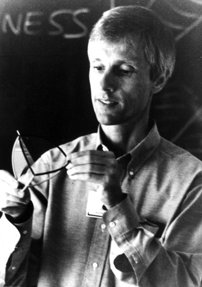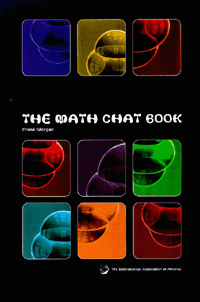- About MAA
- Membership
- MAA Publications
- Periodicals
- Blogs
- MAA Book Series
- MAA Press (an imprint of the AMS)
- MAA Notes
- MAA Reviews
- Mathematical Communication
- Information for Libraries
- Author Resources
- Advertise with MAA
- Meetings
- Competitions
- Programs
- Communities
- MAA Sections
- SIGMAA
- MAA Connect
- Students
- MAA Awards
- Awards Booklets
- Writing Awards
- Teaching Awards
- Service Awards
- Research Awards
- Lecture Awards
- Putnam Competition Individual and Team Winners
- D. E. Shaw Group AMC 8 Awards & Certificates
- Maryam Mirzakhani AMC 10 A Awards & Certificates
- Two Sigma AMC 10 B Awards & Certificates
- Jane Street AMC 12 A Awards & Certificates
- Akamai AMC 12 B Awards & Certificates
- High School Teachers
- News
You are here
Frank Morgan's Math Chat - MATHEMATICS MEETINGS FEATURE PROOF OF DODECAHEDRAL CONJECTURE BYUNDERGRADUATE SEAN MCLAUGHLIN
 |
 |
Last month over 4000 mathematicians held joint meetings in Washington, DC. Thomas Hales of the University of Michigan outlined his proof of Kepler's Conjecture of 1611 on the optimal way to pack unit balls in space (see Math Chat of June 17, 1999). There remained the Dodecahedral Conjecture on the optimal way locally to pack unit balls around one fixed ball. The very symmetric conjectured arrangement, based on the regular 12-faced dodecahedron, cannot be extended to fill all of space; the pieces just don't fit together right. But locally this dodecahedral arrangement exists and beats Hales's global solution. The Dodecahedral Conjecture says it is the optimal local arrangement. This conjecture has now been proved, by Hales's undergraduate student Sean McLaughlin. In Washington McLaughlin received the 1999 Morgan Prize for undergraduate research and spoke on his work. The proof involves extensive computer algebra calculations, including some 2000 possible types of arrangements, 12 or 18 of which were too difficult for the computer and had to be done by hand.
THE MATH CHAT TV student staff spent time last month with the Williamstown Elementary School classes of Susan Pleines (fourth grade) and Lynn Bernstein (fifth grade). Michael Biaocchi's group studied vectors and used them for treasure hunts. Rita Forte's group compiled basketball statistics and created a new game. Fumi Tosu, whose group built a castle from sugar cubes, wrote: "I remember Nick proudly announcing to the other members of the group, 'I need 28 cubes for this wall because it's 11 times 2 and you have to add the 6 bumps!" Brad Uy's group studied volume and density, grappled with objections that "air does not have volume," and built a model boat christened "The Big Kahuna." Brendan Kinnell's group discovered tessellations and, like M. C. Escher, created their own. Heather Stephens's group studied colors and produced beautiful tonal artwork. Eric Bellucci's group created and performed percussion rhythms. Hoyoon Nam's group constructed their own instruments, wrote and recorded a new song, "The Millennium Kids," and sent it in to the local radio station. Sarah Schiavetti's group created a whole new "Greek" myth explaining the phases of the moon, with new words invented from Greek roots, such as the "aristoastros" (best stars). Elizabeth Healy's group wrote a play and performed it. They also wrote poetry in the form of haikus and cinquains. Here are a haiku and two cinquains they wrote:
Butterflies
Different colors,
Beautiful fluttering wings,
It lands on my nose,
Color.
--Katy Markland
Willows
Drooping over rivers
Touching pebbles and catfish
And tickling them.
--Chloe Dircks
Whales
Gracefully swimming
Diving in the salty sea
Splashing all around.
--Lian Larkin
As Chloe said, "It really calms me down to put my ideas into a poem." The groups presented stories and contests at the local Water Street Books and town library, and appeared with the contest winners on the live, call-in Math Chat TV show. They also submitted material to radio and magazines.
OLD CHALLENGE. Just last summer (see June 17 Math Chat) Thomas Hales of the University of Michigan proved that regular hexagons provide the least-perimeter (least-length) way to divide the plane into equal areas. What is the shortest network of curves you can find dividing the surface of the sphere into say four equal areas? five equal areas? other numbers of equal areas?
ANSWER. For four equal areas, Joseph DeVincentis suggests a network based on the regular tetrahedron, with four congruent spherical triangles meeting in threes. For more general numbers of areas, he suggests networks based on the various regular solids: not just the 4-faced tetrahedron, but also the 6-faced cube, and the 8-faced octahedron, not to mention the 12-faced dodecahedron and the 20-faced icosahedron. He correctly notes that the octahedron is not actually optimal, could be improved, as can any example in which the curves meet in fours or more rather than in threes. (Similarly the icosahedron could be improved.) The other three are conjectured to be optimal for 4, 6, and 12 regions. Currently Christopher Chris Cox
For 5 regions, DeVincentis suggests a network based on the triangular prism. (Prisms and antiprisms might help for larger numbers of regions too.)
NEW CHALLENGE. Was there any validity to the claim that the full moon of December 22, 1999 was the brightest that we shall see for millions of years?
Send answers, comments, and new questions by email to Frank.Morgan@williams.edu, to be eligible for Flatland and other book awards. Winning answers will appear in the next Math Chat. Math Chat appears on the first and third Thursdays of each month. Prof. Morgan's homepage is at www.williams.edu/Mathematics/fmorgan.
MATH CHAT TV, the live, call-in show with questions and prizes, will air on the web Wednesdays, February 9 and 16, 7-7:30 pm Eastern time, at raserver.williams.edu/live/MathChat.rm
THE MATH CHAT BOOK, including a $1000 Math Chat Book QUEST, questions and answers, and a list of past challenge winners, is now available from the MAA (800-331-1622).
Copyright 2000, Frank Morgan.




